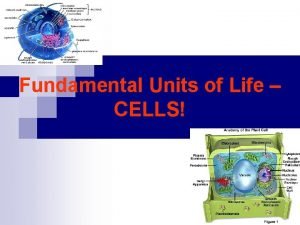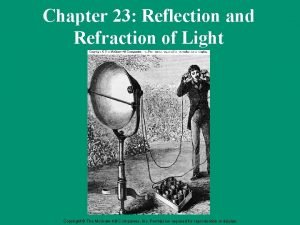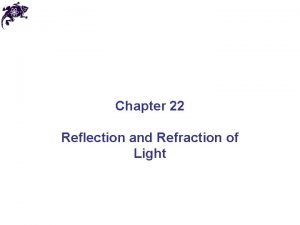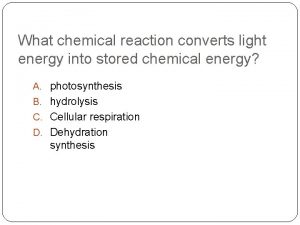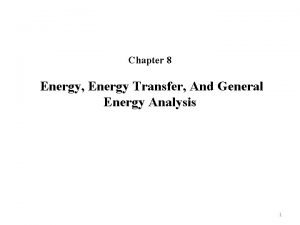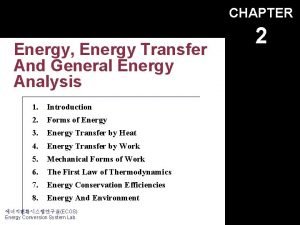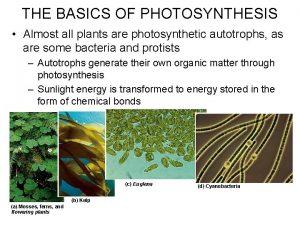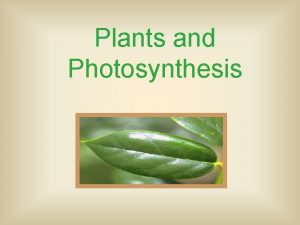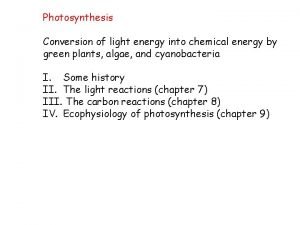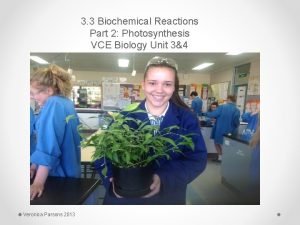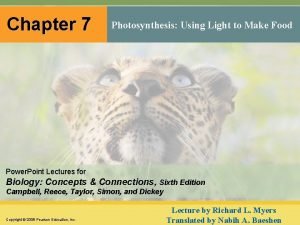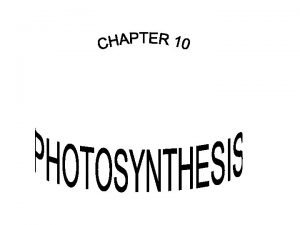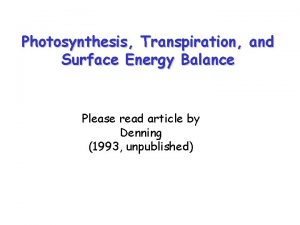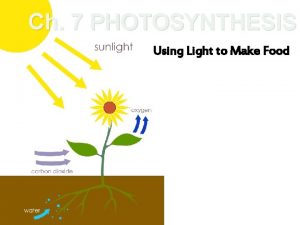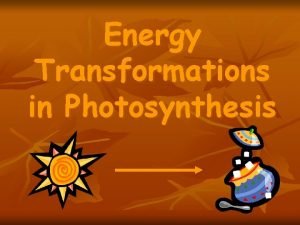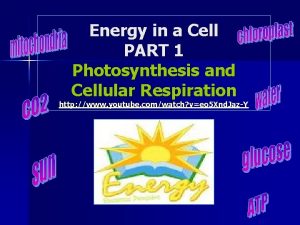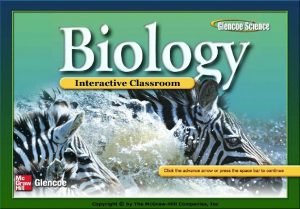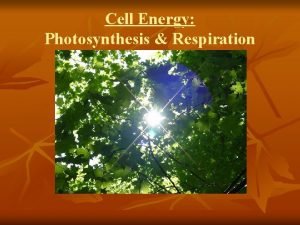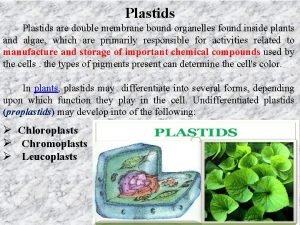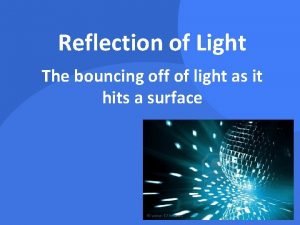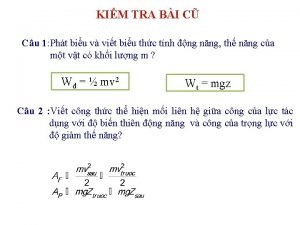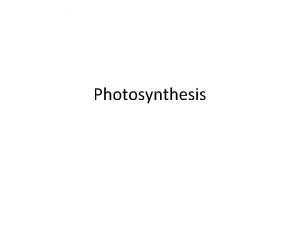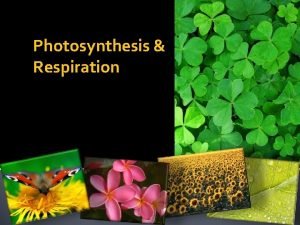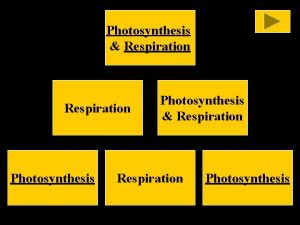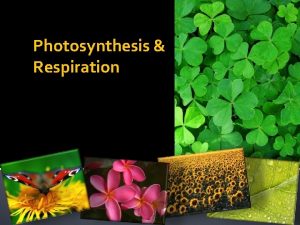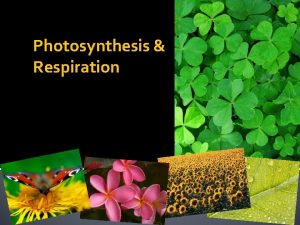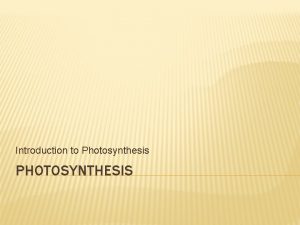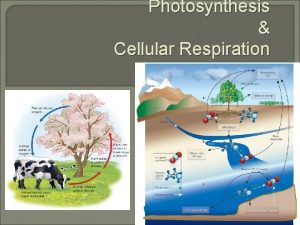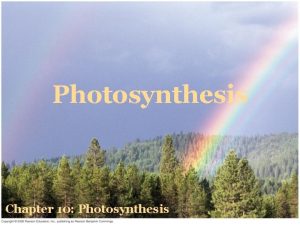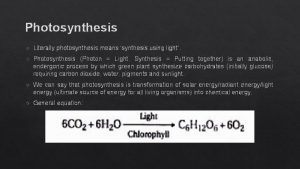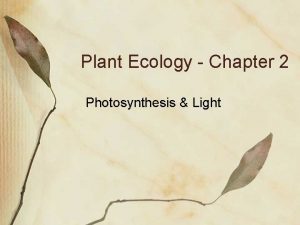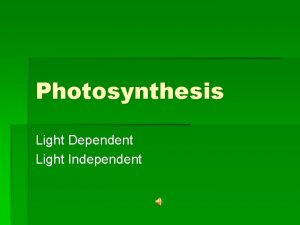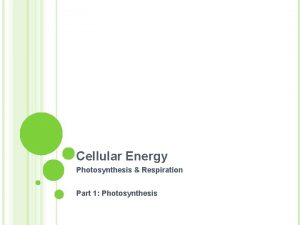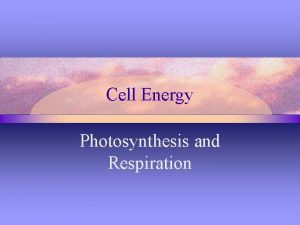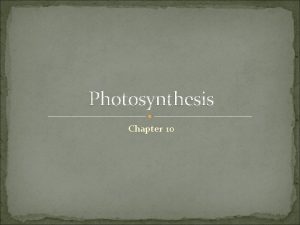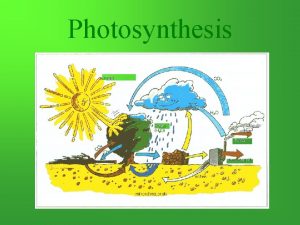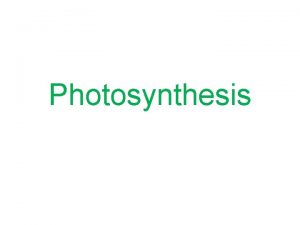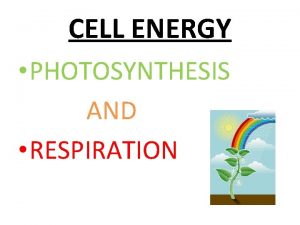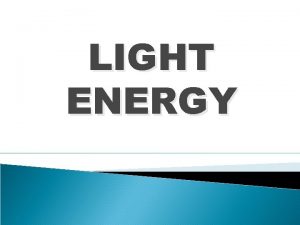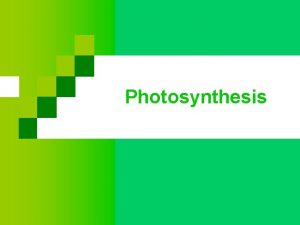PHOTOSYNTHESIS Photosynthesis Involves the Use Of light Energy



































- Slides: 35

PHOTOSYNTHESIS

Photosynthesis Involves the Use Of light Energy to convert Water (H 20) and Carbon Dioxide (CO 2) into Oxygen (O 2) and High Energy Carbohydrates (sugars, e. g. Glucose) & Starches 2

The Photosynthesis Equation 3

PHOTOSYNTHESIS HAPPENS IN CHLOROPLASTS THYLAKOIDS = sac-like photosynthetic membranes inside chloroplast GRANUM (pl. grana) = stack of thylakoids

THYLAKOID SPACES STROMA Gel-filled space inside chloroplast surrounding thylakoid sac Gel-filled space Inside thylakoid sac cytoplasm Gel-filled space OUTSIDE chloroplast but inside the cell membrane

PHOTOSYNTHESIS HAPPENS IN CHLOROPLASTS Proteins that are part of the thylakoid membrane organize Light absorbing PIGMENTS into clusters called ________________ PHOTOSYSTEMS ___________

Pigments • In addition to water, carbon dioxide, and light energy, photosynthesis requires Pigments • Chlorophyll is the primary light-absorbing pigment in autotrophs • Chlorophyll is found inside chloroplasts 7

Light and Pigments Light Contains A Mixture Of Wavelengths Different Wavelengths Have Different Colors 8

Light & Pigments Different pigments absorb different wavelengths of light Energy from light “excites” electrons in the plant’s pigments Excited electrons carry the absorbed energy 9


PHOTOSYNTHESIS Light & Water Light-Dependent Reaction ATP NADPH Light-Independent Reactions Oxygen

LIGHT-DEPENDENT REACTIONS ATP SYNTHASE INSIDE THYLAKOID SPACE ↓ PHOTOSYSTEM II ↓ ↓ ELECTRON TRANSPORT SYSTEM PHOTOSYSTEM I OUTSIDE THYLAKOID IN STROMA

WHY DOES PHOTOSYSTEM II COME BEFORE PHOTOSYSTEM I? It was discovered and named 1 st PHOTOSYSTEM II ↓ ↓ PHOTOSYSTEM I

REMEMBER DIFFUSION? Molecules move automatically from where there’s A LOT to where there’s NOT

Diffusion happens anytime there is a difference in concentration in one place compared to another CONCENTRATION GRADIENT = ____________

LIGHT-DEPENDENT REACTIONS SEE A MOVIE ATP SYNTHASE IN ACTION

LIGHT DEPENDENT REACTION LIGHT Requires _______ Pigments that absorb light are part of THYLAKOID membranes ______________ PHOTOSYSTEMS II & I Made up of ______________ ELECTRON TRANSPORT CHAIN connected by _______________ ATP SYNTHASE & __________ Uses light energy to create ATP and _______ NADPH _____ H 20 molecules and Breaks apart ______ oxygen releases _______

PHOTOSYNTHESIS Light & Water Light-Dependent Reaction Oxygen ATP NADPH Carbon Dioxide Light-Independent Reactions CALVIN CYCLE (CH 2 O)n

PHOTOSYNTHESIS OVERVIEW Pearson Education Inc; Publishing

Calvin Cycle (8 E) Click the image to play the video segment.

CO 2 Enters the Cycle Calvin Cycle Energy Input 5 -Carbon Molecules Regenerated 6 -Carbon Sugar Produced Sugars and other compounds See Calvin cycle animation

CALVIN CYCLE LIGHT INDEPENDENT (also called _____________) DOES NOT require ______ LIGHT ______ Happens in the STROMA _____ between thylakoids Hydrogen + electrons NADPH donates ____________ ENERGY ATP donates _________ Carbon & oxygen CO 2 donates __________ to make GLUCOSE _____ http: //www. estrellamountain. edu/faculty/farabee/biobk/Bio. Book. CHEM 2. html

Factors that Affect Photosynthesis AMOUNT OF WATER __________ Water is one of the raw materials needed, so slow or stop A shortage of water can ________ photosynthesis Desert plants and conifers that live in dry conditions have a waxy coating on their leaves to prevent water loss. http: //www. hononegah. org/departments/Anderson/cactus. JPG

Factors that Affect Photosynthesis TEMPERATURE Photosynthesis enzymes function best between 0° C - 35° C At temperatures above or below this range, photosynthesis will slow or stop Conifers in winter may carry out photosynthesis only occasionally

REMEMBER CELL BIO Enzymes work BEST at a certain temperature p. H and _____. ___ Conditions that are TOO ACIDIC or TOO HOT cause proteins DENATURE to unwind or _____ http: //www. desktopfotos. de/Downloads/melt_cd. jpg http: //www. nealbrownstudio. com/adm/photo/163_n

Denaturing changes the shape of the enzyme making it not work HOMEOSTASIS (keeping p. H and temperature constant) is important for maintaining enzyme function. Image from: http: //www. emc. maricopa. edu/faculty/farabee/BIOBK/Bio. Book. CHEM 2. html

Factors that Affect Photosynthesis LIGHT INTENSITY __________ More light increases rate of photosynthesis up to a certain level until plant reaches its maximum rate of photosynthesis See effect of light experiment http: //www. teachnet. ie/foneill/exper. htm http: //206. 173. 89. 42/REALTYWITHALOHA_COM/piphoto/funny%2

THE BIG PICTURE PHOTOSYNTHESIS provides OXYGEN we breathe _______ sugars and the _____ heterotrophs (like us) consume to survive Carbon WATER dioxide + _____________ Sugars Oxygen ________ + ______

Concept Map Section 8 -3 Photosynthesis includes use to produce takes place in take place in of uses to produce

Concept Map Section 8 -3 Photosynthesis includes Lightdependent reactions Calvin cycle use take place in Energy from sunlight Thylakoid membranes to produce ATP NADPH O 2 takes place in Stroma uses ATP NADPH of to produce Chloroplasts High-energy sugars

SOUTH DAKOTA SCIENCE STANDARDS Chapter 8 - Photosynthesis: The students will be able to: explain the biochemical processes that a plant uses in photosynthesis explain the role ADP-ATP cycle has within the chloroplast of the cell (9 -12. L. 1. 1) explain the light reaction (9 -12. L. 1. 1) explain the steps of photophosphorylation and the Calvin Cycle (9 -12. L. 1. 1)

SOUTH DAKOTA CORE SCIENCE STANDARDS LIFE SCIENCE: Indicator 1: Understand the fundamental structures, functions, classifications, and mechanisms found in living things 9 -12. L. 1. 1. Students are able to relate cellular functions and processes to specialized structures within cells. Photosynthesis and respiration ATP-ADP energy cycle Role of enzymes Mitochondria Chloroplasts

Core High School Life Science Performance Descriptors High school students performing at the ADVANCED level: explain the steps of photophosphorylation and the Calvin Cycle; analyze chemical reaction and chemical processes involved in the Calvin Cycle and Krebs Cycle; predict the function of a given structure; predict how homeostasis is maintained within living systems High school students performing at the PROFICIENT level: describe and give examples of chemical reactions required to sustain life (hydrolysis, dehydration synthesis, photosynthesis, cellular respiration, ADP/ATP, role of enzymes); describe the relationship between structure and function explain how homeostasis is maintained within living systems; predict how life systems respond to changes in the environment; High school students performing at the BASIC level name chemical reactions required to sustain life (hydrolysis, dehydration synthesis, photosynthesis, cellular respiration, ADP/ATP, role of enzymes); recognize that different structures perform different functions; define homeostasis;

SOUTH DAKOTA ADVANCED SCIENCE STANDARDS LIFE SCIENCE: Indicator 1: Understand the fundamental structures, functions, classifications, and mechanisms found in living things. 9 -12. L. 1. 1 A. Students are able to explain the physical and chemical processes of photosynthesis and cell respiration and their importance to plant and animal life. (SYNTHESIS) Examples: photosystems, photophosphorylation, Calvin Cycle and Krebs Cycle

SOUTH DAKOTA ADVANCED STANDARDS LIFE SCIENCE Indicator 1: Understand the fundamental structures, functions, classifications, and mechanisms found in living things. 9 -12. L. 1. 2 A. (Synthesis) Describe how living systems use biofeedback mechanisms to maintain homeostasis. 9 -12. L. 1. 4 A. (Application) Identify factors that change the rates of enzyme catalyzed reactions.
 Photosynthesis transforms light energy into chemical energy
Photosynthesis transforms light energy into chemical energy Light light light chapter 23
Light light light chapter 23 Light light light chapter 22
Light light light chapter 22 Chapter 22
Chapter 22 ________ converts light energy into chemical energy. *
________ converts light energy into chemical energy. * Tenebrism examples
Tenebrism examples Energy energy transfer and general energy analysis
Energy energy transfer and general energy analysis Energy energy transfer and general energy analysis
Energy energy transfer and general energy analysis Inputs of light reactions in photosynthesis
Inputs of light reactions in photosynthesis Light reactions photosynthesis
Light reactions photosynthesis Photosynthesis equation light reaction
Photosynthesis equation light reaction Light dependent phase of photosynthesis
Light dependent phase of photosynthesis The process of photosynthesis
The process of photosynthesis Photosynthesis reaction
Photosynthesis reaction Structure of chlorophyll
Structure of chlorophyll Photosynthesis using light to make food
Photosynthesis using light to make food Radiant energy transformation
Radiant energy transformation Photosynthesis energy transformation
Photosynthesis energy transformation Cellular energy section 2 photosynthesis
Cellular energy section 2 photosynthesis How do plants get glucose
How do plants get glucose Put out that light
Put out that light Distinguish between photosystem 1 and photosystem 2
Distinguish between photosystem 1 and photosystem 2 Bouncing off of light
Bouncing off of light Material blocks light
Material blocks light Hình ảnh bộ gõ cơ thể búng tay
Hình ảnh bộ gõ cơ thể búng tay Bổ thể
Bổ thể Tỉ lệ cơ thể trẻ em
Tỉ lệ cơ thể trẻ em Gấu đi như thế nào
Gấu đi như thế nào Glasgow thang điểm
Glasgow thang điểm Chúa yêu trần thế
Chúa yêu trần thế Các môn thể thao bắt đầu bằng từ đua
Các môn thể thao bắt đầu bằng từ đua Thế nào là hệ số cao nhất
Thế nào là hệ số cao nhất Các châu lục và đại dương trên thế giới
Các châu lục và đại dương trên thế giới Công của trọng lực
Công của trọng lực Trời xanh đây là của chúng ta thể thơ
Trời xanh đây là của chúng ta thể thơ
